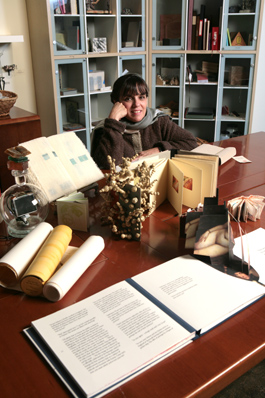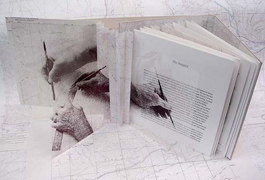home | north bay bohemian index | the arts | books | review

Jamie Sojas
Page Turners: Donna Seager with a few of the unusual artist-made books she specializes in.
World of the Work
Donna Seager Gallery specializes in artist books, no words needed
By Gretchen Giles
"Would you like to see another one?" gallerist Donna Seager asks eagerly. Spread on the reclaimed boardroom table before us is a pile of treasures. Absolutely, I'd like to see another one. "I'll get a textural one this time," Seager says brightly, marching over to a glass-fronted cabinet and pulling on a pair of thin, disposable gloves. She pauses and surveys the cabinet's contents before deftly bending in to pluck up a textural one.
"No story, just little words here and there," she explains, setting an odd little treasure encased in pieces of wood with fluttering strings upon the table. "These are tea bags, but it's more about the wooden structures; it's more about sculpture." She points to the spread before us. "You can see that when you've got a whole bunch of these out on the table, it's a whole world."
Seager, owner of the downtown San Rafael gallery that bears her name, is showing me but a paltry measure of her robust collection of artist-made books. Fine art pieces in their own right, artist books are experiencing something of a renaissance, and Seager is among the leaders of the revolution in alerting the art world at large to the beauty and transformative possibilities in these individual, mostly small, works.
A gallerist for 30 years, Seager had long been aware of artist books. A medium that has ancient antecedents, artist books sprang up as a viable medium in the '50s and '60s, many art historians pointing to L.A. artist Ed Ruscha's 1964 collection of photographs Twenty-Six Gasoline Stations as the first artist book. Today, San Francisco boasts the Center for the Book, Mills College has a healthy curriculum in the art, and small presses devoted to the craft of bookmaking itself abound.
But it wasn't until Seager spent an afternoon four years ago with Charles Hobson, a San Francisco–based artist who also keeps a home and studio in Stinson Beach, that she began to understand the medium's power. "Charles started pulling [artist books] out and showing them to me, sometimes reading little bits aloud to give me a sense of the literature of them, and I wanted them all," Seager remembers. "They're precious, wonderful things. I had seen them before, and I really always loved them, like the collection in the Auchenbach Foundation [at the Palace Legion of Honor] in the city. But they're always under vitrines, and you can't touch them."
Plowing through boxes of disposable gloves each year is just an ordinary business expense for Seager because she so very much wants people to indeed touch the books. "It's an experience of art that is unlike any other because it is intimate, tactile," she says. "It has a whole different rhythm, because as you turn the page, you enter a whole different world. It's exciting. I have found that the people who make the books as well as the people who collect them are special, kind of extraordinary. They are," she pauses to chuckle, "evolved." Seager hosts her third annual exhibition devoted to artist books beginning April 21.
One rarely gets to handle a painting or stroke a piece of sculpture, no matter how alluring. Artist books are generally sized to be held and designed to be handled. "It is an experience," Seager emphasizes. "It's not something that we look at only. I'm not saying that they're better than a painting or anything like that—but they're different. And I have become fascinated by the fact that no two people think alike. Some people will do a whole book focusing on some minutiae—a bird that's extinct now or an idea that they had or a day in their lives. They all end up having their own particular style. Some tend more to craft, some are more conceptual."
Kazuko Watanabe's Diary of a Sparrow, one of the first books that Hobson showed Seager and editions of which she's since almost entirely sold out, combines craft with concept. Sparrow not only tells the story of Watanabe's grandfather, a Japanese villager whose life is chronicled from 1895 to 1963, but the book can be stood on its side and opened up so that the pages fall into a series of diamond shapes that mimic the architecture of dwellings traditional to his area. The paper is of a particular quality, and even the cover has been carefully stained with persimmon juice in honor of metaphor but more practically so that the cover continues to patina and change with age.

'The Mappist': Artist Charles Hobson collaborated with author Barry Lopez to create a book from his short story that works in several dimensions and even features cartography for many of its pages.
As with Sparrow, narrative is sometimes an important part of an artist book, but unlike traditional books, it's not at all necessary. The small wooden treasure with the fluttering strings laid on Seager's boardroom table earlier is composed of commercial tea bags and their air-tight wrappers. Some of Seager's artists, like painter Carol Aust, use books as canvas, painting over pages of ordinary printed tomes. Others, like Marie and Carl Dern, collaborate with authors and even incorporate sculpture for a stand-alone effect. The Derns worked with Marin poet Kay Ryan to handcraft Believe It Or Not, a series of poems Ryan wrote in response to Ripley's book of astounding tales. Carl drew the accompanying images; Marie did the letterpress craft. When creating together, Carl will often make small metal sculptures that can be moved and displayed in context with the book. Charles Hobson specializes in the difficult engineering of clever pop-up books; Macy Chadwick may only create one book a year, but it will be exquisitely considered and often accompanied by its own handmade box; acclaimed printmaker Howard Munson even makes his own bindings. Prices range from the low hundreds to $12,000 and beyond.
Just as Seager is relatively new to the genre, so is her audience. While the artist-made book exhibition opening later this month will feature some 70 pieces, her ordinary gallery schedule features more traditional painting and sculpture on display. But she always has a small rotation of artist books in an open alcove, supporting her passion by having guests regularly lecture on the book arts or host small classes in which visitors can use a letterpress or otherwise get some hands-on time with the medium. "I get to have a little spotlight to shine on things and say, look at this, I think that this is worthwhile," Seager says. "It's exciting to be able to be the one who gets to do that. Hopefully, it raises the bar in the community, because I do think that the more you see, the better you see—the more you begin to know and understand."
With her gallery having just celebrated its second anniversary, Seager is already one of the best-known artist-made book dealers in the United States. She took her collection to the recent Art Basel Miami Beach international art fair and now receives more submissions to the gallery than she could ever show. "[Specializing in artist books] was a risk and a labor of love, and it ended up distinguishing me," she says. "Some of my friends from the city predicted that if I showed artist books, I'd lose my shirt. Now the artist book exhibit is my most successful show of the year. As people come from one show to the next, they get the bug, just as I got the bug.
"And books," she smiles, "are not something where you're going to run out of wall space."
The Donna Seager Gallery exhibits 'The Art of the Book: A Comprehensive Exhibition of New Artist Books' April 21–May 30. 851 Fourth St., San Rafael. 415.454.4229.
Send a letter to the editor about this story.
|
|
|
|
|
|